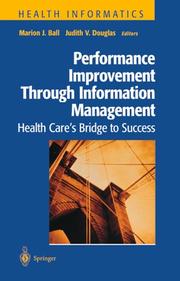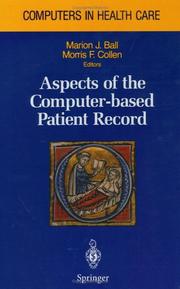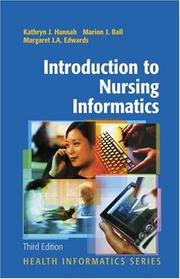| Listing 1 - 10 of 34 | << page >> |
Sort by
|
Book
ISBN: 1849962774 9786613087355 1849962782 1283087359 Year: 2011 Publisher: New York : Springer,
Abstract | Keywords | Export | Availability | Bookmark
 Loading...
Loading...Choose an application
- Reference Manager
- EndNote
- RefWorks (Direct export to RefWorks)
Despite paying more for healthcare than any other country in the world, the US ranks below more than 40 other countries in life expectancy – down significantly from two decades earlier. As the Institute of Medicine concluded, “The current care systems cannot do the job. Trying harder will not work. Changing systems will.” Creating a new system that is “safe, effective, patient-centered, timely, efficient, and equitable” demands transformative change and the health information technology (IT) to support it. For the more than 2.6 million nurses who make up more than half of the national healthcare workforce, IT will be more than an enabler. This fourth edition of Nursing Informatics serves as a definitive guide to the transformation now underway, drawing insight and energy from the initiative known as Technology Informatics Guiding Education Reform (TIGER). Launched by a small group of nurse advocates, TIGER is a guiding force for integration of technology and informatics into education and practice nationally and provides leadership across health professions and delivery settings. Subsequently, it has developed nine collaborative sections that address critical areas for change: education and faculty development, staff development, informatics competencies, standards and interoperability, usability and clinical application design, leadership development, national health information technology agenda, virtual demonstration center, and consumer and personal health record. This new edition reflects the core tenets set forth in the recommendations made by the TIGER initiative, focusing on a range of issues: • Transformation, culture change, and diffusion • Competencies, education, staff development, and leadership • Infrastructure, adoption, and implementation • Comparative effectiveness research and personalized medicine • Global initiatives The editors for this new edition include key nurse advocates and informaticians active in the TIGER initiative: Marion J. Ball, Judith V. Douglas, Patricia Hinton Walker, Donna DuLong, Brian Gugerty, Kathryn J. Hannah, Joan Kiel, Susan Newbold, Joyce Sensmeier, Diane Skiba, and Michelle Troseth.
Computers. --- Information storage and retrieval systems -- Nursing. --- Information Systems. --- Nursing informatics. --- Nursing. --- Nursing informatics --- Information storage and retrieval systems --- Informatics --- Education, Nursing --- Education, Continuing --- Education, Professional --- Information Science --- Education --- Anthropology, Education, Sociology and Social Phenomena --- Nursing Informatics --- Education, Nursing, Continuing --- Health & Biological Sciences --- Medicine --- Nursing --- Medical & Biomedical Informatics --- Nursing literature searching --- Medicine. --- Health informatics. --- Medicine & Public Health. --- Health Informatics. --- Medical informatics --- Data processing --- Medical records --- Data processing. --- EHR systems --- EHR technology --- EHRs (Electronic health records) --- Electronic health records --- Electronic medical records --- EMR systems --- EMRs (Electronic medical records) --- Clinical nursing --- Nurses and nursing --- Nursing process --- Care of the sick --- Medical care --- Clinical informatics --- Health informatics --- Medical information science --- Information science --- TIGER Initiative. --- Informatics, Nursing
Book
ISBN: 0387966390 Year: 1989 Publisher: New York (N.Y.): Springer
Abstract | Keywords | Export | Availability | Bookmark
 Loading...
Loading...Choose an application
- Reference Manager
- EndNote
- RefWorks (Direct export to RefWorks)
Information storage and retrieval systems --- Nursing informatics --- Computers --- Information Systems --- Nursing --- Nursing
Book
Year: 1973 Publisher: Basel, Paris, London Karger
Abstract | Keywords | Export | Availability | Bookmark
 Loading...
Loading...Choose an application
- Reference Manager
- EndNote
- RefWorks (Direct export to RefWorks)
Book
ISBN: 1447167317 1447167325 Year: 2015 Publisher: London : Springer London : Imprint: Springer,
Abstract | Keywords | Export | Availability | Bookmark
 Loading...
Loading...Choose an application
- Reference Manager
- EndNote
- RefWorks (Direct export to RefWorks)
This is a meticulously detailed chronological record of significant events in the history of medical informatics and their impact on direct patient care and clinical research, offering a representative sampling of published contributions to the field. The History of Medical Informatics in the United States has been restructured within this new edition, reflecting the transformation medical informatics has undergone in the years since 1990. The systems that were once exclusively institutionally driven – hospital, multihospital, and outpatient information systems – are today joined by systems that are driven by clinical subspecialties, nursing, pathology, clinical laboratory, pharmacy, imaging, and more. At the core is the person – not the clinician, not the institution – whose health all these systems are designed to serve. A group of world-renowned authors have joined forces with Dr Marion Ball to bring Dr Collen’s incredible work to press. These recognized leaders in medical informatics, many of whom are recipients of the Morris F. Collen Award in Medical Informatics and were friends of or mentored by Dr Collen, carefully reviewed, editing and updating his draft chapters. This has resulted in the most thorough history of the subject imaginable, and also provides readers with a roadmap for the subject well into later in the century.
Medical & Biomedical Informatics --- Medicine --- Health & Biological Sciences --- Medical informatics --- Medical informatics. --- History. --- Clinical informatics --- Health informatics --- Medical information science --- Medicine. --- Health informatics. --- Medicine & Public Health. --- Health Informatics. --- Information science --- Data processing --- Medical records --- Data processing. --- EHR systems --- EHR technology --- EHRs (Electronic health records) --- Electronic health records --- Electronic medical records --- EMR systems --- EMRs (Electronic medical records) --- Information storage and retrieval systems --- Medical care
Digital
ISBN: 9781447167327 9781447167310 9781447167334 9781447171126 Year: 2015 Publisher: London Springer
Abstract | Keywords | Export | Availability | Bookmark
 Loading...
Loading...Choose an application
- Reference Manager
- EndNote
- RefWorks (Direct export to RefWorks)
This is a meticulously detailed chronological record of significant events in the history of medical informatics and their impact on direct patient care and clinical research, offering a representative sampling of published contributions to the field. The History of Medical Informatics in the United States has been restructured within this new edition, reflecting the transformation medical informatics has undergone in the years since 1990. The systems that were once exclusively institutionally driven – hospital, multihospital, and outpatient information systems – are today joined by systems that are driven by clinical subspecialties, nursing, pathology, clinical laboratory, pharmacy, imaging, and more. At the core is the person – not the clinician, not the institution – whose health all these systems are designed to serve. A group of world-renowned authors have joined forces with Dr Marion Ball to bring Dr Collen’s incredible work to press. These recognized leaders in medical informatics, many of whom are recipients of the Morris F. Collen Award in Medical Informatics and were friends of or mentored by Dr Collen, carefully reviewed, editing and updating his draft chapters. This has resulted in the most thorough history of the subject imaginable, and also provides readers with a roadmap for the subject well into later in the century.

ISBN: 0387984526 Year: 1999 Publisher: New York : Springer,
Abstract | Keywords | Export | Availability | Bookmark
 Loading...
Loading...Choose an application
- Reference Manager
- EndNote
- RefWorks (Direct export to RefWorks)
Medical informatics --- Health services administration --- Médecine --- Services de santé --- Informatique --- Administration

ISBN: 0387977236 Year: 1992 Publisher: New York Springer
Abstract | Keywords | Export | Availability | Bookmark
 Loading...
Loading...Choose an application
- Reference Manager
- EndNote
- RefWorks (Direct export to RefWorks)
Medical records --- Medical Records Systems, Computerized --- Data processing
Periodical
Year: 1991 Publisher: New York Berlin London Springer
Abstract | Keywords | Export | Availability | Bookmark
 Loading...
Loading...Choose an application
- Reference Manager
- EndNote
- RefWorks (Direct export to RefWorks)

ISBN: 3540977236 Year: 1992 Publisher: New York London Paris Springer
Abstract | Keywords | Export | Availability | Bookmark
 Loading...
Loading...Choose an application
- Reference Manager
- EndNote
- RefWorks (Direct export to RefWorks)

ISBN: 1280610808 9786610610808 0387321896 038726096X 144192082X Year: 2006 Publisher: New York : Springer,
Abstract | Keywords | Export | Availability | Bookmark
 Loading...
Loading...Choose an application
- Reference Manager
- EndNote
- RefWorks (Direct export to RefWorks)
This series is directed to healthcare professionals who are leading the tra- formation of healthcare by using information and knowledge. Launched in 1998 as Computers in Health Care, the series offers a broad range of - tles: some addressed to speci?c professions such as nursing, medicine, and health administration; others to special areas of practice such as trauma and radiology. Still other books in the series focus on interdisciplinary issues, such as the computer-based patient record, electronic health records, and networked healthcare systems. Renamed Health Informatics in 1998 to re?ect the rapid evolution in the discipline now known as health informatics, the series will continue to add titles that contribute to the evolution of the ?eld. In the series, eminent experts, as editors or authors, offer their accounts of innovations in health informatics. Increasingly, these accounts go beyond hardware and software toaddresstheroleofinformationinin?uencingthetransformationofheal- caredeliverysystemsaroundtheworld.Theseriesalsowillincreasinglyfocus on “peopleware” and the organizational, behavioral, and societal changes that accompany the diffusion of information technology in health services environments. These changes will shape health services in the new millennium. By m- ing full and creative use of the technology to tame data and to transform information, health informatics will foster the development of the kno- edge age in health care. As coeditors, we pledge to support our professional colleaguesandtheseriesreadersastheyshareadvancesintheemergingand exciting ?eld of Health Informatics.
Nursing informatics. --- Nursing. --- Clinical nursing --- Nurses and nursing --- Nursing process --- Care of the sick --- Medicine --- Medical informatics --- Nursing --- Data processing --- Medical records --- Health Informatics. --- Data processing. --- EHR systems --- EHR technology --- EHRs (Electronic health records) --- Electronic health records --- Electronic medical records --- EMR systems --- EMRs (Electronic medical records) --- Information storage and retrieval systems --- Medical care --- Health informatics. --- Clinical informatics --- Health informatics --- Medical information science --- Information science
| Listing 1 - 10 of 34 | << page >> |
Sort by
|

 Search
Search Feedback
Feedback About UniCat
About UniCat  Help
Help News
News